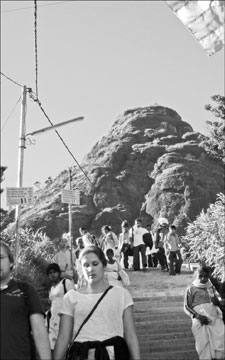‘Karunawai, Karunawai’
Dr Mathu H. LIYANAGE
It’s December, and the annual pilgrimage season to Sri Pada is on.
Traditionally, it starts on the full moon day in December and ends on
the Vesak Full Moon Poya day in May.
The beautiful full moon, covering her delicate face with a silky
cloth to keep her away from the biting cold and the thin mist, peeps now
and then producing a flash of light as if to show the way for the weary
and exhausted pilgrims shivering in the cold who are climbing the
mountain to pay homage to the foot print of the Buddha placed on its
summit.
Break the serenity
Amidst the luxuriant green vegetation and carpet-like tea plantations
at the foot of the mountain, Samanala Kanda, popularly known as Sri Pada
and Adam’s Peak, poses an elegant, picturesque landscape - a rare sight
indeed to behold.
 |
|
Devotees trek to the sacred mountain
peak in their thousands to pay homage to the Buddha's Sacred
footprint. |
The mountain covered with thin mist lies basking in the sun during
the day and takes a good shower of moonlight in the night, especially on
days immediately before and after the full moon. From a distance, the
mountain could be seen as a casket draped in a white silky cloth.
Gleeful shouts of 'karunawai', 'karunawai' (compassion to you,
compassion to you) coming from pilgrims as a way of greeting each other,
ascending or descending the mountain, break the serenity and stillness
of the region. The echo of the word 'karunawai' is capable of softening
even the heart of a hard criminal living far away.
Centuries ago, Samanala Kanda, 7,359 feet in height, was once thought
to be the highest mountain in the world.
It became sacred to most of the religions because of the impression
of the footprint found on its summit. The Buddhists consider it as that
of the Buddha whilst the Hindus claim it as that of God Siva, the Arabs
that of Adam and of St Thomas the Apostle by some Christians. The
Mahawamsa, the Buddhist chronicle, however, says that, at the request of
God Saman, the hereditary deity, the Buddha in his third visit to Sri
Lanka left the impression of his foot on the summit before going to
Dighavapi.
According to legend, King Valagambha, who was dethroned and lived in
exile in the wilderness for 14 years, came to the summit of the mountain
almost accidentally while chasing a deer in one of his hunting trips and
was surprised to see the footprint. The gods had assured him that it was
the footprint of the Buddha.
The sunrise
The Mahawamsa also records that King Vijayabahu donated the village
of Gilimalaya with its rich paddy fields and other plantations to meet
the needs of food and drinks, and other requisites necessary for the
pilgrims to make the pilgrimage easy and comfortable.
Most of the pilgrims to Sri Pada start the trek around 2.00 am in the
morning from Dalhousie at the foot of the mountain to reach its top by
6.00 am to witness the all-conquering sunrise.
The sunrise, as seen from the summit of the mountain, is a strange
phenomenon. The sun that is normally expected to rise gradually is seen
to take a sudden leap over the horizon.
This the moment when more dedicated Buddhists, who firmly believe
that it is the way the sun pays homage to the sacred footprint, are
thrown into a frenzy of deafening chants of “sadhu”, “sadhu” in keeping
with their traditional way of paying their respects and homage to the
sacred footprint of the Buddha.
The beauty and charm of this heart-throbbing spectacle is further
heightened by the appearance on the undulating tableland on the Western
side a perfect triangular shadow of the Samanala Kanda, which, on a
clear day without mist, will appear to stand upright. As the sun rises
higher, the shadow will move towards the base of the mountain and
finally disappear.
|







